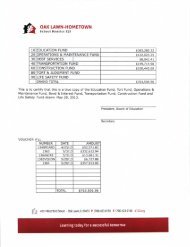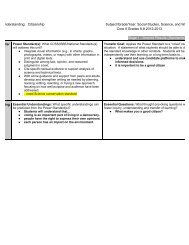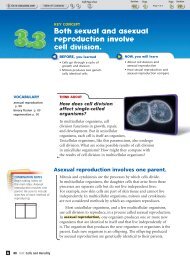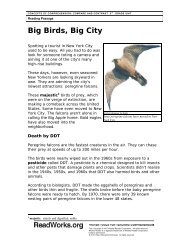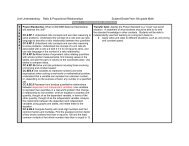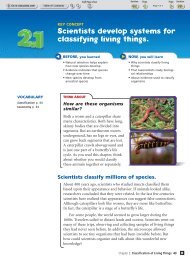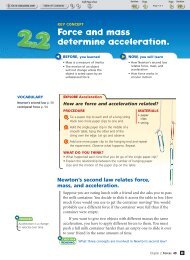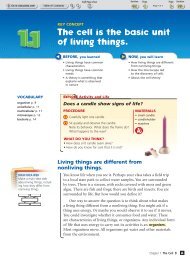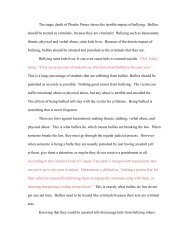(3.2) Cell division is part of the cell cycle. - Durant Road Middle School
(3.2) Cell division is part of the cell cycle. - Durant Road Middle School
(3.2) Cell division is part of the cell cycle. - Durant Road Middle School
Create successful ePaper yourself
Turn your PDF publications into a flip-book with our unique Google optimized e-Paper software.
As a result <strong>of</strong> mitos<strong>is</strong> and cytokines<strong>is</strong>, <strong>the</strong> original—or parent—<br />
<strong>cell</strong> splits into two genetically identical daughter <strong>cell</strong>s. In th<strong>is</strong> case,<br />
<strong>the</strong> term daughter <strong>cell</strong> does not imply gender. It <strong>is</strong> a term scient<strong>is</strong>ts use<br />
to refer to <strong>the</strong>se new <strong>cell</strong>s. Each daughter <strong>cell</strong> comes from half <strong>of</strong> <strong>the</strong><br />
parent <strong>cell</strong>. Each daughter <strong>cell</strong> also receives a complete set <strong>of</strong> DNA<br />
from <strong>the</strong> parent <strong>cell</strong>.<br />
COMBINATION NOTES<br />
As you read, begin to take<br />
combination notes on <strong>the</strong><br />
main idea: <strong>Cell</strong> <strong>div<strong>is</strong>ion</strong><br />
produces two genetically<br />
identical <strong>cell</strong>s.<br />
<strong>Cell</strong> <strong>div<strong>is</strong>ion</strong> produces two genetically<br />
identical <strong>cell</strong>s.<br />
Recall that many <strong>cell</strong>s in your body are continually dividing into new<br />
<strong>cell</strong>s. The new <strong>cell</strong>s help your body grow, develop, repair itself, and<br />
replace worn-out <strong>part</strong>s. Though your body <strong>cell</strong>s divide at different<br />
rates, <strong>the</strong> same process—mitos<strong>is</strong>—divides <strong>the</strong>ir genetic material.<br />
<strong>Cell</strong> <strong>div<strong>is</strong>ion</strong> produces daughter <strong>cell</strong>s that are genetically identical<br />
to each o<strong>the</strong>r, as well as to <strong>the</strong>ir parent <strong>cell</strong>, which no longer ex<strong>is</strong>ts.<br />
Being genetically identical to <strong>the</strong>ir parent <strong>cell</strong> helps <strong>the</strong> new <strong>cell</strong>s function<br />
properly. A skin <strong>cell</strong>, for example, divides and produces skin <strong>cell</strong>s<br />
genetically identical to it. The new skin <strong>cell</strong>s will function in exactly<br />
<strong>the</strong> same way as <strong>the</strong> parent.<br />
Check Your Reading<br />
How are daughter <strong>cell</strong>s like <strong>the</strong> parent <strong>cell</strong>?<br />
VISUALIZATION<br />
CLASSZONE.COM<br />
Watch <strong>the</strong> process <strong>of</strong><br />
mitos<strong>is</strong> in action.<br />
Steps <strong>of</strong> Mitos<strong>is</strong><br />
The process <strong>of</strong> mitos<strong>is</strong> <strong>is</strong> essential in evenly dividing <strong>the</strong> genetic material<br />
between <strong>the</strong> daughter <strong>cell</strong>s. Although mitos<strong>is</strong> <strong>is</strong> a continuous<br />
process, scient<strong>is</strong>ts divide <strong>the</strong> events <strong>of</strong> mitos<strong>is</strong> into four phases.<br />
1<br />
2<br />
3<br />
Chromosomes form. During prophase, <strong>the</strong> DNA in <strong>the</strong> nucleus <strong>of</strong><br />
a <strong>cell</strong> forms chromosomes. Each chromosome cons<strong>is</strong>ts <strong>of</strong> two<br />
identical chromatids held toge<strong>the</strong>r by a centromere. The membrane<br />
around <strong>the</strong> nucleus d<strong>is</strong>appears.<br />
Chromosomes line up. The chromosomes line up in <strong>the</strong> middle<br />
<strong>of</strong> <strong>the</strong> <strong>cell</strong>. Th<strong>is</strong> stage <strong>is</strong> called metaphase.<br />
Chromosomes separate. During <strong>the</strong> stage called anaphase, <strong>the</strong><br />
chromatids split up, forming two chromosomes. The chromosomes<br />
are pulled to opposite sides <strong>of</strong> <strong>the</strong> <strong>cell</strong>.<br />
4 Nuclei form. A new nuclear membrane forms around each group<br />
<strong>of</strong> chromosomes during telophase. The chromosomes return to<br />
<strong>the</strong>ir threadlike chromatin form.<br />
Mitos<strong>is</strong> <strong>is</strong> fin<strong>is</strong>hed, and <strong>the</strong> <strong>cell</strong>’s genetic material has been divided.<br />
Following telophase <strong>the</strong> parent <strong>cell</strong>’s cytoplasm <strong>is</strong> divided to complete<br />
<strong>the</strong> parent <strong>cell</strong>’s <strong>div<strong>is</strong>ion</strong> into two entirely separate daughter <strong>cell</strong>s.<br />
EA<br />
82 Unit: <strong>Cell</strong>s and Heredity



